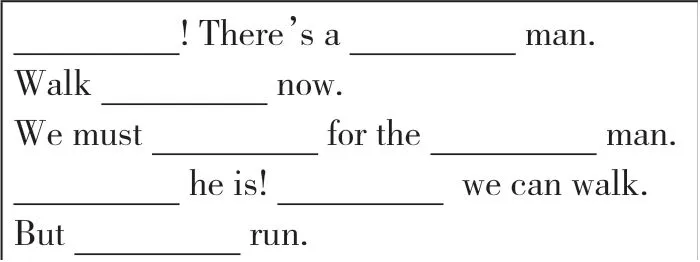学习活动观视域下的英语教学实践与探索
2023-08-02江苏省无锡市梅村实验小学
江苏省无锡市梅村实验小学 徐 琳
新课标指出,英语学习活动观旨在让学生在主题意义引领下,通过学习理解、应用实践、迁移创新等教学活动,整合性地学习语言知识和文化知识,进而运用所学语言知识、技能和策略,围绕主题表达个人观点和态度,解决真实问题,达到在教学中培养学生核心素养的目的。
基于英语学习活动观的英语教学有利于学生获取和梳理语言、文化知识,建构知识体系;有利于学生内化和运用语言、文化知识,提高理解和表达能力;有利于学生联系实际解决真实问题,助推正确的态度和价值观形成。
一、英语学习活动观对英语课堂教学的指导意义
(一)创设真实情境,引导学生乐学善学
英语学习活动观倡导教师要有意识地为学生创设主动参与和探究主题意义的情境和空间。在语篇教学中,教师要根据学生的认知特点,创设真实、有趣的主题情境,围绕主题意义设计丰富多彩的教学活动,调动学生已有的知识经验,在真情境、真问题、真任务的驱动下引导学生感受英语学习的乐趣。
(二)分层设计活动,关注素养提升
学习理解、应用实践、迁移创新等是英语学习活动观的实施路径。教师在设计教学活动时,需要关注学生基于语篇的信息输入、深入语篇的初步输出以及超越语篇的高阶输出,设计由浅入深、关联递进的学习活动,助推学生从学习语言、获取新知、探究意义、解决问题中发展能力,形成素养。
(三)丰富文化内涵,加深主题意义理解
英语学习活动观指出,要引导学生整合性地学习语言知识和文化知识,确保语言学习的过程成为学生文化意识构建的过程。教师要关注文化知识的比较和探究,基于语篇,适时、适度地拓展与主题相关的文化知识,丰富文化内涵,加深学生对语篇主题意义的理解。
(四)融合教学资源,促进目标达成
关注教学内容的完整性是英语学习活动观的基本特征之一。教师要把握超越语篇的学习活动要求,融合课内外资源,丰富课堂教学,引导学生在新情境中利用所学内容创造性地解决问题、表达观点,确保教学目标的达成。
(五)开展持续性评价,推动“教—学—评”一体化
英语学习活动观强调评价活动要贯穿教与学的始终。教师要设计与目标对接的评价活动,让评价活动发挥监控教与学过程和效果的作用,将评价融入教学活动中,使其成为教学的一部分,从而达成预期的教学目标,以评促学,以评促教。
二、英语学习活动观指导下的课堂教学设计与实施
(一)解读教材、分析学情,制订教学内容与目标
文本解读是落实活动观、实现学科育人的逻辑起点。深入解读文本、分析学情能够帮助教师更好地把握教学内容与目标,积极促成学生核心素养的形成。译林版英语六年级下册Unit 4Road safety的单元主题是交通规则意识,板块涉及语篇、语法、语音、文化等内容,各板块围绕“What must we do on the road?”和“What mustn’t we do on the road?”展开教学。本文以该单元第三课时Sound time > Cartoon time板块为例。Sound time是重读语音板块,结合了第一课时故事板块的内容,将行人应该遵守交通信号灯的规则用韵律诗的形式有趣呈现。学生在第一课时中已经学习了作为行人,如何安全地过马路,了解了安全出行必须做和不能做的事情,形成了遵守交通规则的意识。Cartoon time板块讲述了小老鼠Bobby和姐姐Tina乘坐公交车去看望他们的姑姑,沿途公交车司机遵守交通信号灯和礼让行人的卡通故事。教师基于英语学习活动观,对应学科能力提升的三个维度,在主题情境的引领下,建构主题意义(见表1),整体设计教学内容与目标(见表2)。

表1 基于英语学习活动观的主题意义建构

表2 课时教学内容与目标
(二)基于英语学习活动观,设计并实施教学活动
1.基于语篇,学思结合
[教学片段1]
教师设计“Look and match”活动让学生复习Story time中的重要词组,并让学生总结:作为一个遵守交通规则的行人,必须和不应该在马路上做什么。
S1: A good pedestrian must look for a zebra crossing.
S2: A good pedestrian must look at the traffic lights.
教师总结该部分主题意义:A good pedestrian should follow the rules and stay safe on the road.
Story time的复习为下一个环节Sound time的呈现做铺垫。在教学Sound time前,学生已有的关于行人如何遵守道路安全的知识与经验被唤醒,同时激发了对道路安全的探究兴趣。
T: Now, you know how to be a good pedestrian. Can you try to fill the blanks to make a rhyme(见图1)and tell others how to be a good pedestrian?

图1
这个学习任务是学生用力“跳一跳”就能“够到”的难度,而且富有节奏的韵律诗深受六年级学生喜欢,他们非常愿意尝试创编。填写完后,教师播放Sound time板块中重读的教学视频,让学生学习如何正确重读句子中需要强调的单词。在填一填、学一学的过程中,学生更好地体会到了哪些单词需要重读以及应该如何突出句子中的重点单词。
在该教学片段中,教师引导学生获取和梳理文本信息,通过小组合作的形式整合和提炼关键信息,最后形成韵律诗。在教学过程中,学生的探究意识、逻辑思维和学习能力等得到了提升。
[教学片段2]
教师结合马路的卡通图片,询问学生:“路上除了行人,还有什么呢?”学生回答“司机”后,教师引出Cartoon time的学习:“今天,Bobby和Tina去看他们的姑姑。他们在路上遇到了什么司机呢?”教师设计“Listen and choose”“ Watch and answer”环节,引导学生围绕问题“What kind of driver do they meet? ”和“What do they see on the bus?”进行交流和讨论。
T:On the road, except pedestrians, there are some drivers too. Then, how to be a good driver? Today, Tina and Bobby go to see their aunt. They meet a driver. What kind of driv
er do they meet?
1.Listen and choose (听课文第一段录音)
S: They meet a bus driver.
T:Great! How did you get the answer?
S: You can take a bus.
T: A clever boy! Now, let’s get on the bus with Bobby and Tina and enjoy the view. Watch carefully and tell me what do they see on the bus.
2.Watch and answer
T: What do they see on the bus?
S1: They see many cars and bikes.
S2: They see a lot of people.
在该教学片段中,教师引导学生解读文本的第一部分,要求学生基于问题,通过听、看等方式记忆重点、认真思考,丰富了学生的感知和认知。
在本文解读环节,教师设计活动“Look and find”和“Read and think”,引导学生对“Who is the bus driver?”“Is Mr. Koala a good driver?” 两个问题进行分析、质疑,展开对本文的深度阅读。
1.Look and find
T: Who is the bus driver?
S1: Mr. Bear.
S2: Mr. Koala.
T:Why?
S1: Mr. Bear sits in the front of the bus.
S2: Mr. Koala sits in the front of the bus too.Look, he is on the first floor.
S3: I agree. And Mr. Bear is talking all the way, so he must not be the driver.
T: Great! Can a good driver talk all the way?
S: No. It is dangerous.
T: Let’s focus on the second and the last pictures. (见图2、图3)Please look at them carefully and find who the bus driver is .

图2

图3
S: Mr. Koala.
T: Excellent! You all get the right answer. It is a doubledecker bus.The bus driver sits on the first floor. This kind of bus is very popular in the UK. Did you ever see the bus?
S1: Yes, I see it in our city centre.
2.Read and think
T: Yes. There are some double-decker buses in our country now. You can take them someday and find where the bus driver is. Now, we find that the bus driver is Mr. Koala.Do you think he is a good driver? Please read the story and think about it. You can discuss in the groups.
S1: I think Mr. Koala is a good driver. Because he stops the bus when the traffic light is red.
S2: I think so. Because he stops the bus when the elephants are crossing the road.
T: Well done. So what should a good driver do on the road?
S1: A good driver must look at the traffic lights.
S2: A good driver must yield to pedestrians.
教师基于两个问题,引导学生对本教学片段的主题意义进行了深度思考和主动探究,同时设计看图和阅读两个任务,帮助学生梳理和获取信息,建立图片与文本信息、图片与学生已知经验(司机坐在车辆前面)之间的关联。教师基于问题、基于任务的教学活动,为学生构建了一个有层次、有梯度、有意义的思考空间,发展了他们检索信息、整合重点、审慎思辨的能力。
2.深入语篇,学用结合
[教学片段3]
在讨论并明确了好司机应该有哪些行为后,教师设计活动“Think and create”,引导学生模仿Sound time中的小诗,根据给出的两组关键词,进行意义仿写,让学生将所学重读知识运用在新的语篇环境中,培养学生在新的任务和情境中构建对知识的内化和运用的能力,促进Cartoon time的高阶输出,增加Sound time的知识厚度。
Think and create
T:A good driver should follow the rules and stay safe on the road.Can you try to fill the blanks to make a new rhyme and tell others how to be a good driver?
S1: Stop!There’s a red light.
We mustn’t drive now.
We must wait for the green light.
There he is! Now we can drive.
But don’t drive too fast.
T: Wonderful! How do you think of her rhyme? How many stars can she get?
S2: I think she can get 3 stars. The full mark!
T: Thank you! I love the rhyme too. Then can you read her rhyme with the correct stress? Have a try!
(生尝试)
T: Well done! You make a super rhyme .
这个学习任务是学生努力“跳一跳”也能“够到”的难度。在该教学片段中,教师借助仿写活动,帮助学生重塑了卡通文本,内化了重读知识,渗透了价值观教育,锻炼了学生归纳整合、关联概括等思维能力,落实了英语学科的育人价值。同时,教师注重同伴互评、教师评价和自评,教育学生学会赞美与欣赏,激发了学生的积极性和自信心。
3.超越语篇,学创结合
[教学片段4]
在拓展环节,教师选用课外视频资源动画片Traffic Safety with POLI中的Safe Cycling和Bicycle Safety两个小视频,选用符合学生兴趣及认知的英文动画片资源,引入学生现阶段正在经历却又似懂非懂的如何安全骑自行车的场景,形成真实互动,丰富课堂内容,完善主题情境。
T:Can you ride?
S: Yes! I can ride and I always ride at weekends.
T: Can you ride safety? Are you a good rider? Here are some questions about safe riding. Do it by yourself.(见图4)

图4
T:Can you figure out all the questions?
S:No.
T: Let’s watch two videos about safe riding. You will learn a lot from Poli and his friends.
T: Now check your answers and correct them.
在以上教学活动中,授课教师充分尊重学生的生活经验、知识基础、心理基础等,调动学生的情绪,确保学生成为学习活动的主体。在完成知识问答后,授课教师引导学生总结此部分的主题意义,输出目标句型“A good rider must/must not...”
T: Can you say something about a good rider? You can discuss with your partner.
S1: A good rider must ride on the bicycle lanes.
S2: A good rider must wear protective gear.
S3: A good rider must not play on the road.
S4:A good rider must get off and walk the bike when crossing the road.
S5:A good rider must put both hands on the handlebar.
S6: A good rider must use hand signals correctly.
S7: A good rider must do safety checks.
T: Excellent!
这个学习任务是学生尽力“跳一跳”才能“够到”的难度。学生在以生活为背景的真实情境中,通过自主、合作、探究等学习方式,综合运用语言技能,进行多元思维,实现知识迁移,促进深度学习,助推学生能力向素养转化。
英语学习活动观秉持的“在体验中学习、在实践中运用、在迁移中创新”的学习理念对课堂教学有着显著的指导意义。教师应积极落实英语学习活动观,创设真实情境,发挥学生的主体作用,提高教学实效,促进学生语言、思维、价值观等的综合发展。
